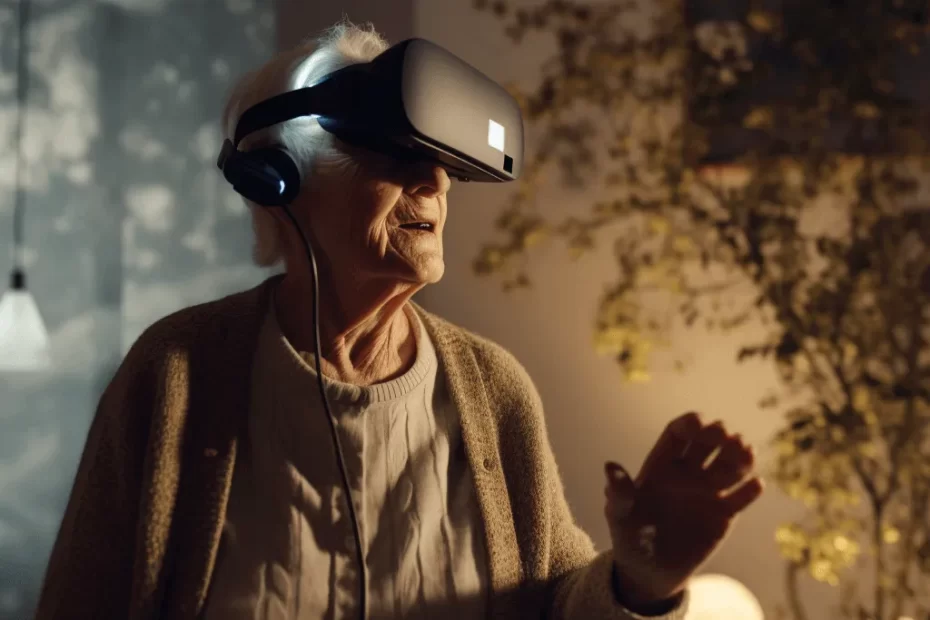Virtual reality (VR) is no longer just a tool for gamers and tech enthusiasts; it is now transforming the lives of seniors, offering new ways to explore the world, relive memories, and engage in experiences that may otherwise be inaccessible. This article is worth reading for anyone interested in how cutting-edge technology can significantly improve the quality of life for older adults. Whether you’re a senior, a family member, or a caregiver, understanding the benefits of VR can open up a whole new world of possibilities.
Virtual Reality and Why It Is Important for Seniors
Virtual reality technology offers a unique and immersive way to experience the world, using a VR headset to transport the user into a virtual environment that feels incredibly real. For seniors, this cutting-edge technology opens up a whole new world of possibilities, especially for those with limited mobility or health issues that restrict their ability to travel or engage in certain activities.
Virtual reality for seniors is important because it addresses several key challenges faced by older adults. Whether it’s reducing isolation, providing cognitive stimulation, or simply offering a new way to enjoy virtual experiences, VR has the potential to significantly enhance the quality of life for seniors. As VR technology becomes more accessible and user-friendly, it is becoming an increasingly valuable tool in senior living environments.
How Can Seniors Benefit from Virtual Reality?
Virtual reality offers numerous benefits for seniors, both mentally and physically. One of the most significant advantages is its ability to improve mental health by reducing stress and anxiety. Seniors who may be suffering from loneliness or depression can find solace in the immersive experience that VR provides, allowing them to escape into a virtual world where they can relax, socialize, or explore.
Physically, VR technology can also help seniors stay active. Certain VR applications are designed to encourage movement, whether it’s through virtual exercise programs or interactive games that require physical participation. These activities can help maintain mobility and improve overall fitness levels, which are crucial for healthy aging.
Socially, virtual reality can reduce feelings of isolation by connecting older adults with their peers, family, and friends in a virtual space. Seniors can attend virtual events, join online communities, and even experience the world alongside others, all from the comfort of their own homes.
Choosing the Right VR Headset for Seniors
Selecting the right VR headset is crucial for a positive virtual reality experience. For seniors, comfort, ease of use, and safety are the top priorities when choosing a vr headset. Lightweight designs, adjustable straps, and user-friendly interfaces are essential features that make the headset more accessible to older adults.
Popular options include the Oculus Quest 2 and the Vive Flow, both of which are known for their ergonomic designs and intuitive controls. For those who may need a more straightforward option, there are VR headsets specifically designed to be suitable for seniors, with simplified interfaces and built-in safety features.
Ensuring a comfortable VR experience also involves considering factors like battery life, screen resolution, and compatibility with different vr applications. It’s important to test the headset beforehand and make sure it meets the specific needs of the senior who will be using it.

Virtual Reality Applications for Seniors: What Are the Possibilities?
The range of virtual reality applications available for seniors is vast and continues to grow. From travel experiences that allow seniors to virtually visit new places, to educational programs that provide cognitive stimulation, VR offers endless possibilities for exploration and learning.
One of the most popular uses of virtual reality among seniors is virtual travel. This allows older adults to explore the world without leaving their homes, offering a safe and convenient way to visit landmarks, museums, and even far-off countries. For those who love to experience new things, VR provides an opportunity to see places they might never have the chance to visit in real life.
Beyond travel, VR is also being used for therapeutic purposes, such as in dementia care. Immersive VR therapy can help seniors relive positive memories, engage in calming activities, and even improve their cognitive functions. The benefits of virtual reality in this context are still being explored, but early results are promising.
Is Virtual Reality Safe for Seniors?
Safety is a common concern when introducing virtual reality to seniors. While VR is generally safe, there are certain risks that need to be addressed to ensure a positive experience. For example, the immersive nature of VR can cause dizziness or disorientation in some users, so it’s important to take regular breaks and avoid sessions that are too long.
To help seniors adapt to VR, it’s recommended to start with simple, non-intense experiences and gradually introduce more complex applications. Ensuring the headset fits properly and is adjusted for comfort can also prevent physical discomfort during use.
For seniors with existing health conditions, such as dementia, it’s crucial to consult with a healthcare professional before using VR. While there are many benefits of VR for seniors, it’s important to approach this new technology with caution and care.
How to Get Started with Virtual Reality Option for Seniors
Getting started with virtual reality is easier than it might seem. The first step is to choose a VR headset that meets the needs of the senior. Once the headset is selected, setting it up typically involves downloading the necessary software, adjusting the fit, and learning the basic controls.
For seniors new to virtual reality, it can be helpful to start with guided experiences that are specifically designed for beginners. Many vr applications offer tutorials and easy-to-follow instructions, making it simple for older adults to dive into the world of virtual reality.
Encouraging seniors to explore at their own pace is key. There’s no rush to master everything at once; the goal is to make the experience enjoyable and stress-free. Over time, as seniors become more comfortable with the technology, they can begin to explore more advanced features and applications.
Virtual Reality Headset for Seniors with Dementia: A New Therapeutic Approach
Virtual reality is proving to be a valuable tool in dementia care, offering immersive VR therapy that can improve the quality of life for seniors with cognitive decline. By creating immersive experiences that engage the senses, VR can help seniors reconnect with their memories, experience calming environments, and even reduce symptoms of agitation.
One of the key benefits of VR therapy for dementia patients is its ability to provide a safe and controlled environment where seniors can engage in activities that may no longer be possible in the real world. This can include anything from a virtual walk around Paris to revisiting childhood homes or familiar places.
While research is still ongoing, early results suggest that immersive VR therapy can help lessen the impact of dementia and improve overall mood and well-being. It’s an exciting development in the field of senior care, offering a new way to support seniors and their families.
Virtual Reality Travel Experiences: Seniors Exploring the World from Home
For seniors who love to travel but are no longer able to do so, virtual reality offers an exciting alternative. Through VR travel experiences, seniors can virtually visit some of the world’s most famous landmarks, from the Great Wall of China to the Grand Canyon, all without leaving the comfort of their own homes.
These travel experiences are more than just visual; they are fully immersive and can include sounds, interactive elements, and even guided tours. This allows seniors to explore new places and cultures, keeping their minds engaged and curious.
For many seniors, these virtual visits are a way to relive past travel memories or fulfill lifelong dreams of visiting certain destinations. The ability to experience the world in such a way can be incredibly fulfilling, offering a sense of adventure and exploration even in later years.

Virtual Reality in Senior Living Communities
Many senior living communities are beginning to see the value of integrating virtual reality technology into their activities and therapy programs. By offering VR experiences, these communities are able to provide residents with unique opportunities for social interaction, cognitive stimulation, and even physical activity.
For example, some communities are using VR therapy as a way to engage residents with dementia, offering them a safe and comforting way to relive memories or enjoy relaxing environments. Others are using VR to create social experiences, such as group travel tours or interactive games that residents can participate in together.
The future of virtual reality in senior living looks promising, with many communities planning to expand their use of VR technology. As the technology continues to evolve, it will likely become an even more integral part of senior living environments, offering seniors more ways to enjoy virtual experiences.
Overcoming Challenges: Helping Seniors Embrace Virtual Reality
While the potential benefits of virtual reality for seniors are vast, there are also challenges to be addressed. One of the biggest barriers is the technology itself, which can be intimidating for older adults who are not familiar with digital devices. However, with the right support and training, these challenges can be overcome.
To make VR more accessible to seniors, it’s important to provide clear instructions, patience, and encouragement. Starting with simple and enjoyable experiences can help build confidence and interest in the technology. Additionally, involving family members or caregivers in the process can make the experience more enjoyable and less daunting.
Success stories abound of seniors who were initially hesitant about VR but went on to embrace it wholeheartedly. Whether it’s a 90-year-old exploring Paris for the first time in a virtual environment or a group of residents at a senior living community bonding over a shared VR experience, these examples show that with the right approach, seniors can fully enjoy the benefits of virtual reality.
Summary: Key Takeaways on VR for Seniors
- Virtual reality offers a whole new world of possibilities for seniors, from travel experiences to cognitive stimulation.
- The benefits of virtual reality include improved mental and physical health, social interaction, and reduced isolation.
- Choosing the right VR headset is crucial for a positive experience, with comfort, ease of use, and safety as top priorities.
- VR applications for seniors range from travel and education to therapy for conditions like dementia.
- Safety is important; starting with simple experiences and ensuring a comfortable setup can help seniors adapt to VR.
- Virtual reality is being increasingly integrated into senior living communities, offering residents new ways to engage and interact.
- Overcoming the challenges of technology adoption is possible with the right support, leading to successful and enjoyable VR experiences for seniors.
My name is Jason, and I'm passionate about the latest technologies, especially VR 🎮, AR 🌐, and XR 🚀. I love exploring how these exciting advancements can be used in different areas of life to make everyday experiences better.


